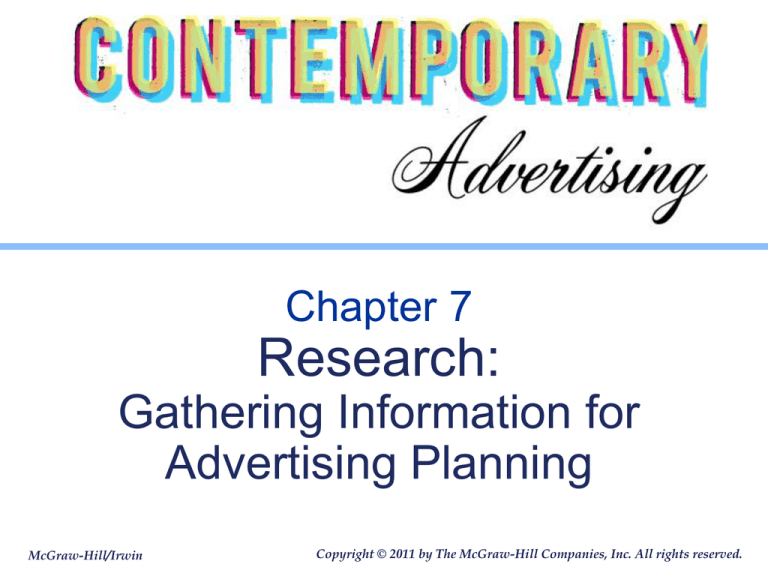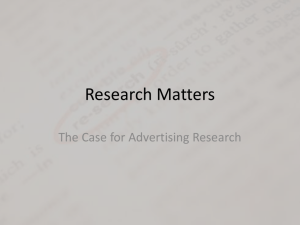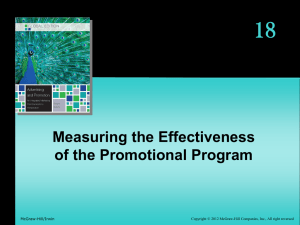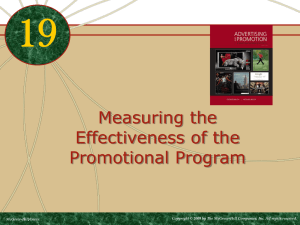
Chapter 7
Research:
Gathering Information for
Advertising Planning
McGraw-Hill/Irwin
Copyright © 2011 by The McGraw-Hill Companies, Inc. All rights reserved.
Chapter Overview
How advertisers gain information
about the marketplace and
then apply their findings
7-2
Chapter Objectives
Discuss how research
locates market segments
and target markets
Define and explain validity
and reliability
Explain the steps in the
research process
Recognize issues in
creating survey
questionnaires
Discuss differences
between formal/informal
research and
primary/secondary data
Explain the challenges in
collecting research data
abroad
Explain the methods used
in qualitative and
quantitative research
Debate the pros and cons
of advertising testing
7-3
What is Marketing Research?
Functions
Consumer Needs
& Market Segments
Purposes
Recruit New
Customers
Product Development
Assess Effectiveness
Financial Planning
Retain Current
Customers
Regain Lost
Customers
Quality Control
7-4
What is Marketing Research?
Nielsen ad for market research services
7-5
Applying Advertising Research
7-6
Applying Advertising Research
Media
Selection
Product
Concept
Strategy
Research
Target
Audience
Selection
MessageElement
Selection
7-7
Concept Pretesting & Post-testing
Pretesting Decisions
Post-test Decisions
Merchandise
Whether and how
to continue
Markets
Motives
Messages
Media
What to change
How much to
spend in the future
7-8
Media Categories
7-9
Steps in the Research Process
1. Analyze situation
and define problem
2. Conduct informal
(exploratory) research
Primary Data
Secondary Data
Internal
External
3. Establish research
objectives
4. Conduct formal
research
Qualitative
Quantitative
5. Interpret and report
findings
7-10
Qualitative Methods: Intensive techniques
Projective
Techniques
Observation, Experimentation,
Surveys
Focus
Groups
Feelings,
attitudes,
interests,
opinions, needs,
motives
In-Depth
Interviews
Interaction reveals true
feelings and behavior
7-11
Qualitative Methods
A focus group is especially effective when used
in conjunction with market surveys
7-12
Quantitative Methods
Experiment
Survey
Observation
7-13
Quantitative Methods
The Universal
Product Code
(UPC) label
allows
measurement
of advertising
response
7-14
Quantitative Methods
Envirosell uses cameras to capture in-store
consumer shopping habits
7-15
Methods for Pretesting Ads
Print Ads
Direct questioning
Portfolio test
Focus group
Mock magazine
Order-of-merit test
Perceptual meaning
study
Paired comparison
Direct mail test
7-16
Methods for Pretesting Ads
Broadcast Advertising
Central location
projection test
Live telecast test
Trailer test
Sales experiment
Theater test
7-17
Methods for Pretesting Ads
Physiological Testing
Pupilometric device
Voice pitch analysis
Eye movement
camera
Brain pattern
analysis
Galvanometer
7-18
Post-testing Methods
Post-testing
Aided recall
(recognition-readership)
Unaided recall
Aptitude tests
Inquiry tests
Sales tests
7-19
Issues in Advertising Research
Sampling
Method
Questionnaire
Development
Validity
Quantitative
Research
Considerations
Data Tabulation
& Analysis
Reliability
International
Data Collection
7-20
Issues in Advertising Research
Reliability/Validity Diagram
7-21
International Data Research
Challenges
Higher expense
Control and direction
Language and culture
Longer lead times
Lack of standardization
7-22
Developing Effective Questionnaires
List specific objectives
Start with easy questions
Keep them short
Logical flow to questions
State questions clearly
No leading questions
Write a rough draft
Use cross-checking
Short opening statement
End with demographics
Pretest the questionnaire
7-23












